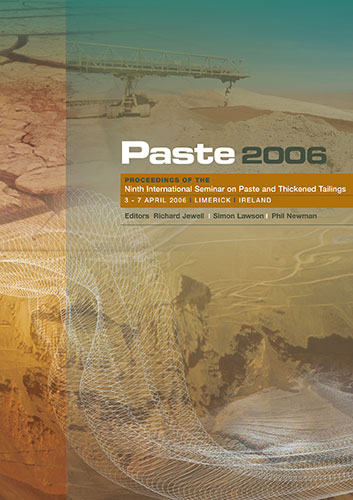Technical Challenges in Paste Thickener Designs with Process pH Extremes

|
Authors: Hooimeyer, E |
DOI https://doi.org/10.36487/ACG_repo/663_7
Cite As:
Hooimeyer, E 2006, 'Technical Challenges in Paste Thickener Designs with Process pH Extremes', in R Jewell, S Lawson & P Newman (eds), Paste 2006: Proceedings of the Ninth International Seminar on Paste and Thickened Tailings, Australian Centre for Geomechanics, Perth, pp. 69-78, https://doi.org/10.36487/ACG_repo/663_7
Abstract:
Paste thickeners have become more prevalent in various stages of minerals processing flow sheets in recent years. Although such flow sheets are easily derived and conceptually simple, as with many things in minerals processing, the successful designing from flow sheet to an operating process plant can be the challenge. This paper examines some of the ‘real life’ technical challenges in paste thickener designs for processes with slurries at the extreme ends of the pH scale. The use of paste thickeners in the Bayer Process for extracting alumina from bauxite will be reviewed, where the main carrier liquid is a high concentration caustic (pH 14) at an elevated temperature of over 100 oC. The resulting design must not only prevent high stress concentrations, potentially accelerating structure fatigue, but also retain the heat, as heat loss is detrimental to the process. At the other end of the pH scale, Pressure Acid Leach is used in nickel laterite plants where the ore is treated with sulphuric acid with high levels of chlorides (pH 1). Here the materials of construction and the fine detail of the connections are critical to the structural integrity of the thickener. Any contact between the acid and carbon steel will lead to highly accelerated corrosion. There are other project-specific challenges that can relate to process conditions or construction issues. This paper will present some of the construction challenges that Outokumpu has worked through with its clients.
© Copyright 2025, Australian Centre for Geomechanics (ACG), The University of Western Australia. All rights reserved.
View copyright/legal information
Please direct any queries or error reports to repository-acg@uwa.edu.au
View copyright/legal information
Please direct any queries or error reports to repository-acg@uwa.edu.au